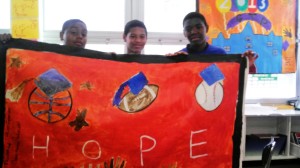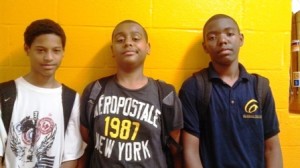A Student's Hope for Education
Rachel Sacks is a former Teaching Fellow at Citizen Schools New York. She is currently pursuing graduate art therapy programs and taking classes at John Jay College.

The Mural Making class display looked more like a museum than a middle school project. Long canvas murals stretched around the room, lay on the floors, and hung on the walls. As I walked around the showcase event, I was amazed to see what the students had learned during their Citizen Schools "apprenticeship" classes. I approached one group of students to ask about their piece, an evocative image of multi-colored hands reaching up for sports balls and college graduation caps. The word “Hope” was emblazoned across the top. One student, Justin, greeted me and began the tour of the mural that he and his teammates, Josniel and Elijah, called, “Hope for Education.”
Led by a talented artist affiliated with Creative Arts Workshops, the students in the mural apprenticeship approached the process of creating their project with rigor. As they explained the decisions they made in selecting each symbol and color, what at first looked like a straightforward picture became something much more complex. These eighth-grade boys, just a month away from graduating from middle school, were aware of the challenges ahead of them. With a certain gravity, they explained the bittersweet depth of the mural.
Their particular hope for education was, as Josniel said, "to get the [graduation] statistics up for Blacks and Latinos." To show this, they placed some of the tan and brown hands lower than the white hands to signify how many young men of color do not finish high school or go onto college.

Countless news articles remind us of the inequities in our education system. A recent report by the Schott Foundation for Public Education revealed that 52% of black males and 58% of Latino males who entered ninth grade in 2006 graduated in four years, as opposed to 78% of white, non-Latino males. Those who do graduate high school are also significantly less likely than their white peers to graduate from college within six years.
This challenge comes through in the strong symbols of the students’ mural. "Hope is small for us, and we have to reach out for it, to get our goals," Josniel said, demonstrating a resolve that the boys all shared. Each facet of the mural merged challenge with courage. They chose red as the background color, “to represent blood and sweat we put into our work, always reaching for our goals.” They included symbols for sports to convey how athletics and education intertwine, explaining that sports help many young men of color get college scholarships.
Yet for all the elements of reality and struggle that the students so honestly depicted, they did not skimp on hope. Their group name, “Rainbow Panda with Golden Wings,” was based on Josniel’s motto-- “because there’s nothing you can’t do, got to just try, put in the hard work. Like Justin can be an NBA player if he dunks enough.”
And with the help of programs like Citizen Schools and the expanded learning time model, students affected by the opportunity gap, whose families often cannot afford private tutors or music lessons, can get the time to dunk enough: three extra hours a day of class time that includes homework support, math enrichment, college prep, and of course, real-world apprenticeship classes like Mural Making.
 These opportunities extend far beyond the classroom, shaping the confidence of young people who are given the chance to meet artists, engineers and business executives. With these mentors, they create a tangible product over the course of ten weeks, and develop the confidence and grit they need to succeed.
These opportunities extend far beyond the classroom, shaping the confidence of young people who are given the chance to meet artists, engineers and business executives. With these mentors, they create a tangible product over the course of ten weeks, and develop the confidence and grit they need to succeed.
Armed with their achievements, these young men surely have a sense of what they were reaching for. Besides sharing with me the various high schools they will be attending in the fall, they also shared their dreams for college, sport scholarships, and careers. Elijah wants to attend LSU, and become a marine biologist. Justin wants to play football or become a video game designer. And Josniel wants to attend Harvard or Yale, and become a defense attorney and/or a poet.
With a paintbrush in their hands and dedicated volunteers and teachers behind them, these students aren’t about to let statistics hold them back.